|
Fancy
learning how to cast a fly for salmon or trout? Why not
spend a few hours on a tranquil lake in Sussex learning
how!
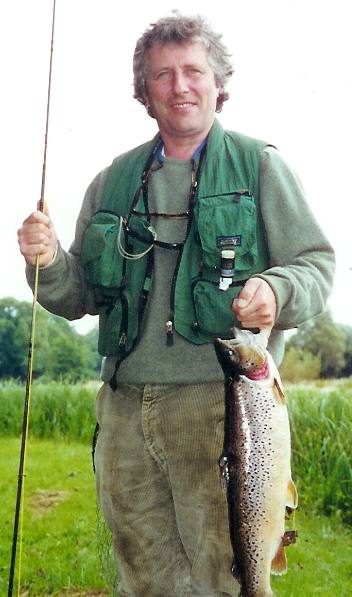
A
7lb brown trout caught using dry fly on the river Test
I've
caught well over a thousand salmon on the fly and many
more sea, rainbow and brown trout. I can teach you how
to cast a fly on a one-to-one basis for £45 per hour -
all equipment is included. Children under the age of 16
must be accompanied by an adult. There is a spacious
cabin for refreshments for those accompanying fishing
students.
WHAT
IS FLY FISHING?
Fly fishing is an angling method in which an artificial 'fly' is used to catch fish. The fly is cast using a fly rod, reel, and specialized weighted line. Casting a nearly weightless fly or 'lure' requires casting techniques significantly different from other forms of casting. Fly fishermen use hand tied flies that resemble natural invertebrates or other food organisms, or 'lures' to provoke the fish to strike.
Fly fishing can be done in fresh or salt water. North Americans usually distinguish freshwater fishing between cold-water species (trout, salmon, steelhead) and warm-water species, notably bass. In Britain, where natural water temperatures vary less, the distinction is between game fishing for trout or salmon and coarse fishing for other species. Techniques for fly fishing also differ with habitat (lakes and ponds, small streams, large rivers, bays and estuarys and open
ocean.) Fly fishing is "The Contemplative Man's Recreation".
In fly fishing, fish are caught by using Artificial flies that are cast with a fly rod and a fly line. The fly line (today, almost always coated with plastic) is heavy enough to send the fly to the target. The main difference between fly fishing and spin or bait fishing is that in fly fishing the weight of the line carries the hook through the air, whereas in spin and bait fishing the weight of the lure or sinker at the end of the monofilament or braided line gives casting distance. Artificial flies are of several types; some imitating an insect (either flying or swimming), others a bait fish or crustacean,
other attractors are known to attract fish although they look like nothing in nature. Flies can be made either to float or sink, and range in size from a few millimeters to 30 cm long; most are between 1 and 5 cm.
Artificial flies are made by fastening hair, fur, feathers, or other materials, both natural and synthetic, onto a hook. The first flies were tied with natural materials, but synthetic materials are now popular and prevalent. Flies are tied in sizes, colors and patterns to match local terrestrial and aquatic insects, baitfish, or other prey attractive to the target fish species.
Fish species
Fly fishing is most renowned as a method for catching trout and salmon, but it is also used for a wide variety of species including pike, bass, panfish, grayling and carp, as well as marine species, such as redfish, snook, tarpon, bonefish and striped bass. Many fly anglers catch unintended species such as chub, bream and rudd while fishing for 'main target' species such as trout. A growing population of anglers attempt to catch as many different species as possible with the fly. With the advancement of technology and development of stronger rods and reels, larger predatory saltwater species such as wahoo, tuna, marlin and sharks have become target species on fly. Realistically any fish can be targeted and captured on fly as long as the main food source is effectively replicated by the fly itself and suitable gear is used.
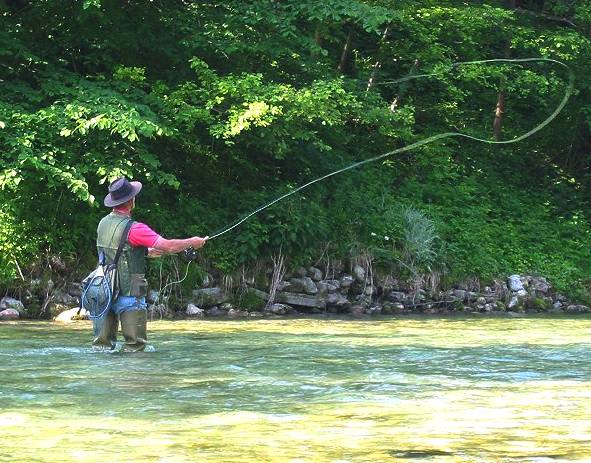
Fly
fishing on a river
Casting
Unlike other casting methods, fly fishing can be thought of as a method of casting line rather than lure. Non-flyfishing methods rely on a lure's weight to pull line from the reel during the forward motion of a cast. By design, a fly is too light to be cast, and thus simply follows the unfurling of a properly cast fly line, which is heavier and tapered and therefore more
cast-able than lines used in other types of fishing.
The physics of fly-casting can be described by the transfer of impulse, the product of mass and speed through the rod from base to top and from the transfer of impulse through the fly line all the way to the tip of the leader. Because both the rod and the fly line are tapered the smaller amount of mass will reach high speeds as the waves in rod and line
unfurl. The waves that travel through the fly line are called loops. Determining factors in reaching the highest speeds are the basal frequency of a rod and the transfer of the speed from the tip of the rod to the fly line. At the moment the rod tip reaches its highest velocity the direction of the cast is determined.
The type of cast used when fishing varies according to the conditions. The most common cast is the forward cast, where the angler whisks the fly into the air, back over the shoulder until the line is nearly straight, then forward, using primarily the forearm. The objective of this motion is to "load" (bend) the rod tip with stored energy, then transmit that energy to the line, resulting in the fly line (and the attached fly) being cast for an appreciable distance. However, just bending the rod and releasing it to jerk the fly line forward (like a bowstring or a catapult) will not propel the fly line and fly very far. More important is the movement of the rod through an arc acting as a lever, magnifying the hand movement of the caster (of about a foot) to an arc at the rod tip of several feet. Here the rod acts as a lever. In fact, one of the Class 3 types of lever, where the The force is applied between the fulcrum and the load (like tweezers). The fulcrum in the fly cast is below the caster's hand gripping the rod; the load is at the rod tip; between the hand exerts the force. The caster's "stroke" backwards and forwards, for the backcast and the forward cast, operates the rod as a (slightly flexible) lever. Casting without landing the fly on the water is known as 'false casting', and may be used to pay out line, to dry a soaked fly, or to reposition a cast. Other casts are the roll cast, the single- or double-haul, the tuck cast, and the side- or curve-cast.
|
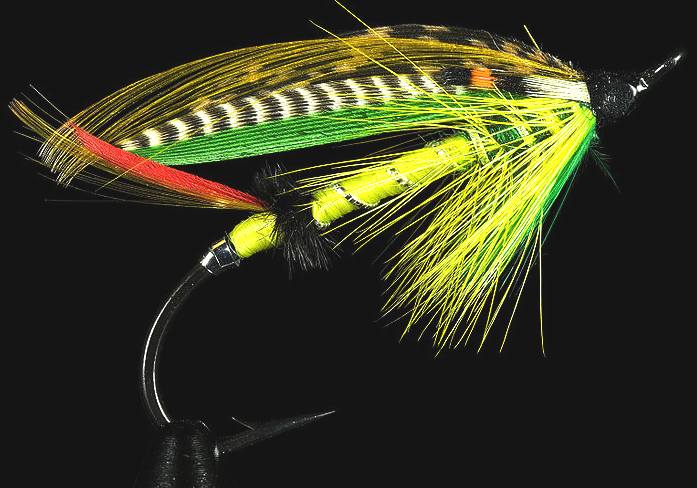
|
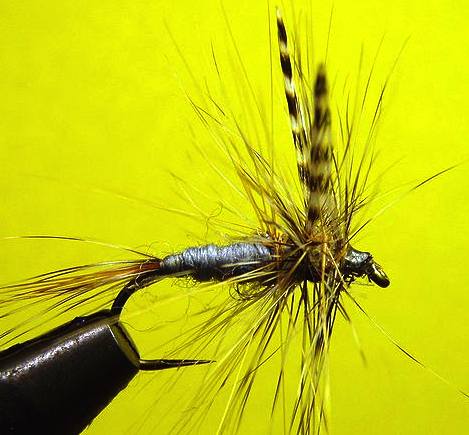
|
|
Highlander
salmon dry fly |
Adams
dry fly |
Dropping the fly onto the water and its subsequent movement on or beneath the surface is one of fly fishing's most difficult aspects; the angler is attempting to cast in such a way that the line lands smoothly on the water and the fly appears as natural as possible. At a certain point, if a fish does not strike, depending upon the action of the fly in the wind or current, the angler picks up the line to make another presentation. On the other hand, if a fish strikes, the angler pulls in line while raising the rod tip. This "sets" the hook in the fish's mouth. The fish is played either by hand, where the angler continues to hold the fly line in one hand to control the tension applied to the fish, or by reeling up any slack in the line and then using the hand to act as a drag on the reel. Most modern fly reels have an adjustable, mechanical drag system to control line tension during a fish's run.
Beginners tend to point with the rod to where they want to throw, but the movement of the hand has to be a controlled speed-up and then come to an abrupt stop. The rod will then start to unfurl and the tip of the rod will reach a high speed in the required direction. The high speed of the rod tip toward the target gives the impulse to make the cast, the abrupt stop and retreat of the rod tip is essential for the formation of a loop. Experienced fishermen also improve the
speed of the line leaving the rod tip by a technique called hauling, applying a quick fast pull with the hand holding the line. At the end of the cast when the line is stretched the line as a whole will still have speed and the fisherman can let some extra line through their fingers making a false throw, either forward or backward or to finish the cast and start fishing.
There are a great number of special casts meant to evade problems like trees behind the angler (roll cast), the pulling of the line on the fly by the action of the stream, or to make the fly land more softly.
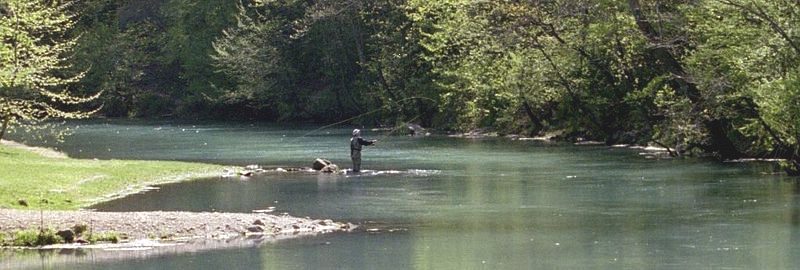
Fly casting, Maramec Spring Branch, Missouri
Reach Casting
The Reach Cast involves casting the fly over flowing water, such as a stream, and then just before the fly lands, moving the arm and fly rod in the upstream direction to arrange the fishing line so that it produces less apparent drag in the
water. This technique is commonly called "mending" your fly line. Reach casting also allows an experienced caster to pitch curved casts in order to get the flies into difficult places.
Spey Casting
Spey casting is a casting technique used in fly fishing. Spey casting requires a longer, heavier two-handed fly rod, referred to as a Spey
rod. Spey casting is essentially a large roll cast, developed on the Scottish River Spey where high banks do not allow space for the usual back cast.
Spey casting is used for fishing large rivers for salmon and large trout such as steelhead and sea trout. Spey technique is also used in saltwater surf casting. All of these situations require the angler to cast larger flies long distances. The two-handed Spey technique allows more powerful casts and avoids obstacles on the shore by keeping most of the line in front of the angler.
Fly fishing for trout
Fly fishing for trout is a very popular sport, which can be done using any of the various methods and any of the general types of flies. Many of the techniques and presentations of fly fishing were first developed in fishing for trout. There is a misconception that all fly fishing for trout is done on the surface of the water with "dry flies." In most places, especially heavily fished trout areas, success usually comes from fly fishing using flies called "nymphs" that were designed to drift on the bottom of the water. This is called "nymphing". A trout feeds below the water's surface nearly 90 percent of the time. Trout usually only come to the surface when there is a large bug hatch (when aquatic insects grow wings and leave the water to mate and lay eggs). There are exceptions to this rule, however, particularly during the summer months and on smaller mountain streams
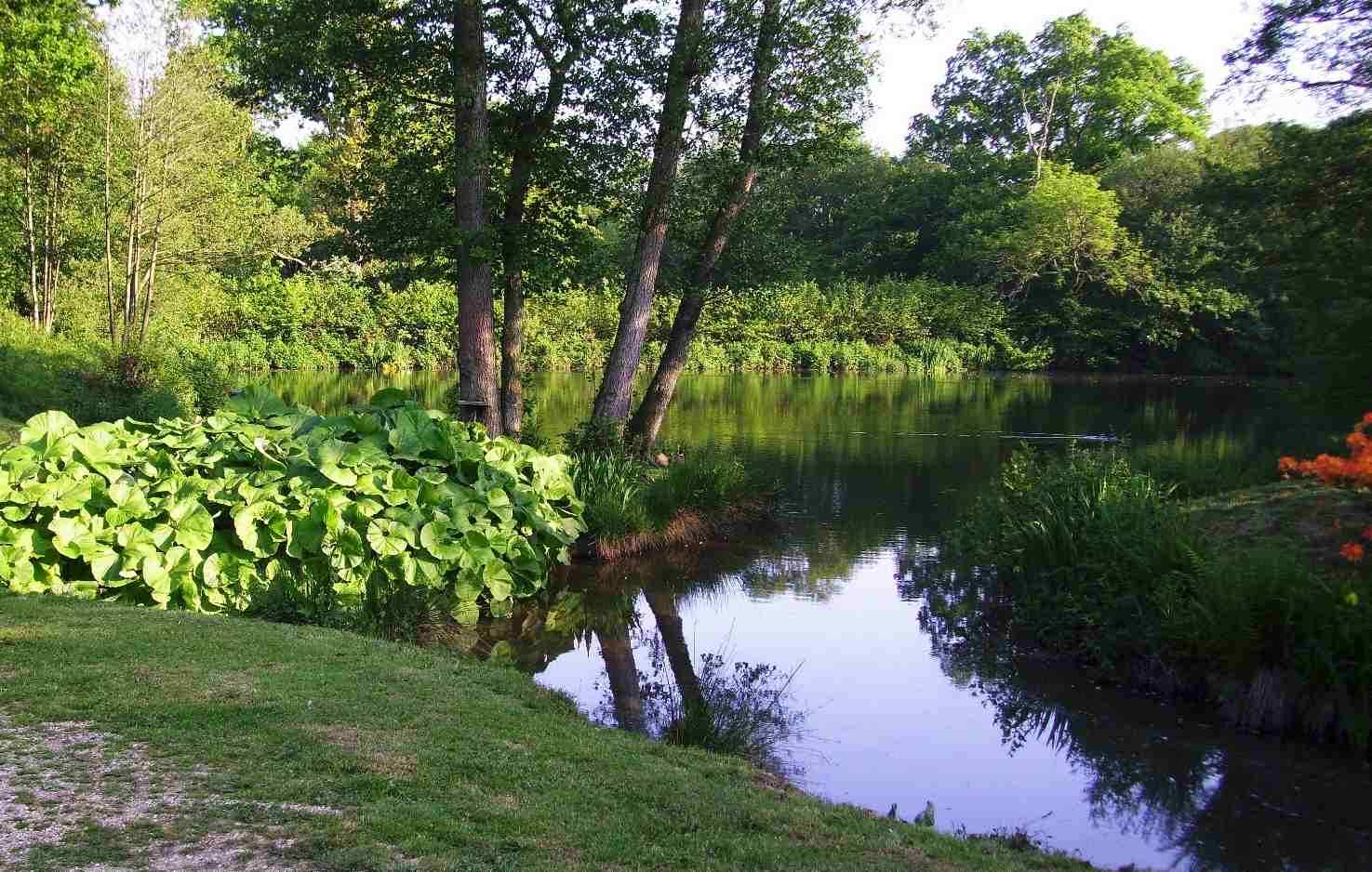
This
is the lake you'll be learning to cast on in Sussex
Distance
from major towns: Brighton 28 miles - Tunbridge Wells 17
miles - Eastbourne 17 miles - Uckfield 10 miles.
If
you wish to enquire about lessons, or would like to
come and see the location, please telephone 01435 867178
when full directions will be given.
Alternatively,
email:
charlescwarren @ hotmail . com
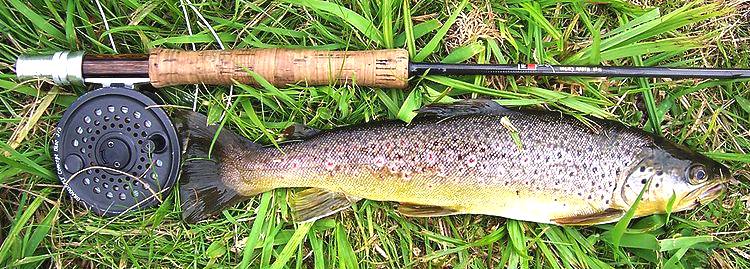
Fly rod and reel with a brown trout from a chalk stream in England
|
Fly
fishing New Zealand - Youtube
|
Tight
Lines fly
fishing - Youtube
|
|
Ladies
flycasting - Youtube
|
The
basics of fly fishing - Youtube
|
LINKS:
HOLIDAY
CABIN RENTAL
CLICK
HERE FOR DETAILS
FILM
LOCATION
CLICK
HERE
|






